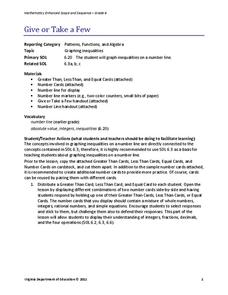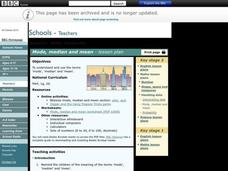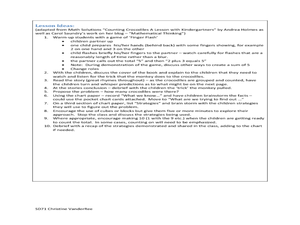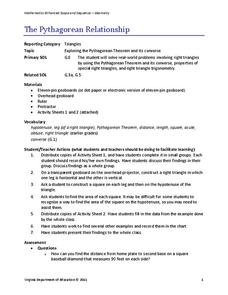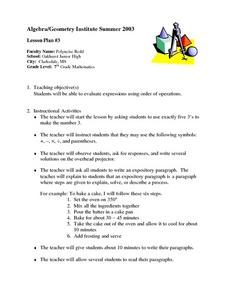Curated OER
Geometric & Arithmetic Patterns
Eighth graders explore sequences. They discuss the difference between an arithmetic sequence and a geometric pattern. Students participate in workstation activities where they determine arithmetic or geometric patterns and predict the...
Virginia Department of Education
Give or Take a Few
Young mathematicians extend their knowledge of rational numbers on a number line to graph inequalities by first using number cards to compare rational numbers. They finish by using similar reasoning to graph inequalities on a number line.
Virginia Department of Education
Inductive and Deductive Reasoning
Introduce pupils to the two types of reasoning, inductive and deductive. Classmates work in pairs or small groups to learn the difference between the two and apply these reasonings to develop valid conclusions.
Curated OER
The Dragon Curve Fractal
Students identify the properties of a dragon curve. In this geometry lesson, students identify sequences and patterns as they solve fractals. They investigate patterns found in nature.
Curated OER
Mode, Median, and Mean
Students define mode, median and mean, and perform mathematical operations to determine these 3 terms. In this statistics/math lesson, students practice memory strategies to help distinguish between mode, median, and mean. Students apply...
Curated OER
Book Title: Counting Crocodiles by Judy Sierra
Students explore number sequence in a variety of activities. In this number practice lesson, students play a game of finger flash and read the book Counting Crocodiles. Students discuss the counting elements in the book and chart the...
Curated OER
Telling the Time
Students practice telling time by completing the various activities. In this telling time lesson plan, students view a large clock and discuss the words 'to' and 'past' the hour. Students count in 5s using the clock and then set their...
Curated OER
Fractal and the Dragon Curve
Students explore Fractal designs. In this geometry lesson, students observe the different polygons created in nature and relate it to math. They define polygons on planes and rotate polygons about a point.
Curated OER
Fractions and Recipes
Learners, working with their parents in real world situations, calculate to complete three word problems associated with multiplying and dividing fractions.
Virginia Department of Education
Logic and Conditional Statements
If there is a conditional statement, then there is a hypothesis and conclusion. Pupils learn how to identify the parts of conditional statements. Class members continue to work with conditional statements and rewrite them in their many...
Curated OER
Graphing Coordinates
Sixth graders practice graphing coordinates. In this geometry lesson plan, they use the x and y axis to locate points that must be connected in the right sequence to form a straight line.
Virginia Department of Education
Lines and Angles
Explore angle relationships associated with transversals. Pupils construct parallel lines with a transversal and find the measures of the angles formed. They figure out how the different angles are related before constructing...
Virginia Department of Education
How Many Triangles?
Something for young mathematicians to remember: the sum of any two sides must be greater than the third. Class members investigates the Triangle Inequality Theorem to find the relationship between the sides of a triangle. At the same...
Virginia Department of Education
Angles, Arcs, and Segments in Circles
Investigate relationships between angles, arcs, and segments in circles. Pupils use geometry software to discover the relationships between angles, arcs, and segments associated with circles. Class members use similar triangles to...
Curated OER
Skip Counting
In this math worksheet, students complete 6 number patterns in which students fill in the missing numbers while skip counting. The addition pattern is already indicated for students. All numbers on the page are between 1 and 35.
Curated OER
Counting to 15
In this counting worksheet, students count from given numbers to given numbers, filling in the missing numbers in each sequence. Worksheet uses numbers 1-15. A reference web site is given for additional activities.
Texas Instruments
Serious Series
High schoolers are introduced to infinite series, geometric and telescoping series as well as the relationship between the sequence of partial sums of a series and its sum. They apply symbolic capacity of their calculator and calculus to...
Virginia Department of Education
The Pythagorean Relationship
Add up areas of squares to discover the pythagorean relationship. Small groups create right triangles with squares along each side. They calculate the areas of each square and notice the relationship. Groups construct other types of...
Virginia Department of Education
Properties of Quadrilaterals
What type of quadrilateral is that? Discover the difference between the types of quadrilaterals. Small groups investigate types of quadrilaterals using geometry software to find their properties. To keep track of the different...
Curated OER
Evalating Expressions
Seventh graders investigate the concepts realted to using the Order of Operations. They write an expository paragraph to prepare for the direct instruction of the order or sequence to simplify numerical expressions.
Curated OER
Operations For Polynomials
Eighth graders investigate how to combine polynomials using different operations. The use of tiles is done in order to accommodate those who are kinesthetic learners. The sequencing of the lesson is easy to follow.
Curated OER
Problem Solving: Patterns in the Coordinate Grid
Coordinate graphs can be used for a variety of purposes. In this basic instructional activity on coordinate graphing, 4th graders learn how to identify points and patterns on a graph. This instructional activity could be used as a follow...
Virginia Department of Education
Evaluating and Simplifying Expressions
Discover how algebra tiles help evaluate expressions. Scholars learn to use algebra tiles to substitute values in for variables and evaluate expressions. The included worksheet contains a set of evaluation problems to assess individuals'...
Virginia Department of Education
Multiplying Polynomials Using Algebra Tiles
Tiles are not just for algebra—see how they can help with multiplication too. Young mathematicians learn to use algebra tiles to model the multiplication of polynomials. A follow-up worksheet provides practice with the skill.



